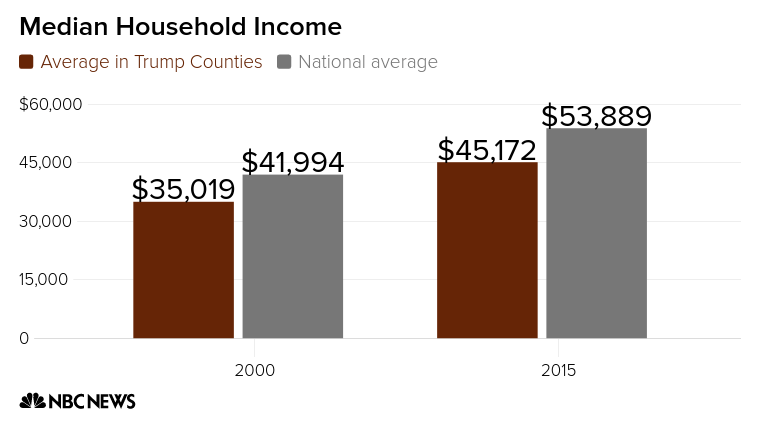WASHINGTON — Voters in the key counties that fueled President Donald Trump’s victory last November aren't exactly the economically depressed group they are often portrayed to be. Rather, those in the counties surveyed in a recent NBC News/Wall Street Journal poll are a collection of lower and middle-income Americans who are doing fine by key economic measures but are concerned that they, and their families, are falling further behind.
And 70 percent of adults in the poll said they aren't confident that life for their children’s generation will be better than theirs.
The NBC News/WSJ poll looked at 439 counties in 16 states that Trump flipped from Barack Obama 2012 or where Trump beat 2012 GOP nominee Mitt Romney's margin of victory by 20 points or more. The survey showed Trump’s support was better in those places than the rest of the nation — 50 percent in those counties approve of the president, compared to 40 percent who said the same in the most recent national NBC News/WSJ poll.
On the whole, these counties are much less racially and ethnically diverse than the nation at large, 86 percent are white and non-Hispanic compared to a national figure of 62 percent. And these areas contain fewer college graduates — 20 percent of those 25 and older have a degree, compared to 30 percent nationally.
Those numbers fit with the common perception that these Trump voters are more disadvantaged than those in other parts of the country. But using some key measures of economic health, the 439 Trump counties don’t look that different from the rest of the country and don’t appear to be struggling.
Related: Voters in Trump Counties Like His Policies, Not His Style
The May unemployment rate in these counties is in line with the national figure of 4.1 percent. That figure is close to a level of unemployment that always exists in economies due to people moving from job to job. And the counties Trump flipped from Obama actually came in a little lower than the national number at 3.9 percent.
And when it comes to health insurance, the Trump counties actually have a greater percentage of their population covered than the nation as a whole, going by 2015 data — 89.4 percent in the Trump flip surge counties versus 87 percent nationally.
Those are not numbers that show places that are barely making it, they show stability and even economic strength. So what is driving the concerns in these counties? The numbers show a slow drift further behind the nation in terms of income.
The average median household income for the 439 counties, $45,172, is below the national average of $53,889. No one wants to sit below the national average, of course, but the Trump county number is not that much lower — it is still squarely in the middle fifth of median household incomes in the United States.
The real concern in the Trump counties is losing ground. In 2000, the average median household income in these places was about $7,000 below the national median. By 2015, the difference between those counties and the national figure was nearly $9,000.

And in some of the 439 Trump counties, the shifts were remarkable.
Take Jackson County Indiana, in 2000 the county’s median household income, $39,401, was about $2,600 below the national median. By 2015 its median household income, $47,000, was about $7,000 below the national median.
In Macomb County Michigan, the median household income in 2000, $52,102, was more than $10,000 above the national median. By 2015, its median household income was $54,582, still above the national median, but only by about $700 dollars.
The voters who live in these places don’t worry about how they compare to the nation at large, they compare their lives to how they used to be, what they used to be able to afford that they now can’t. And even if unemployment or health insurance figures are still good in the national sense, that comparison to the way things used to be doesn’t paint a positive picture for them.
That’s an important thing to remember about these 439 Trump counties. They are still with the president, but their measuring stick for success is going to be tricky. By the most basic economic measures life in these places is not terrible. But it used to be better and that is what they want back.
